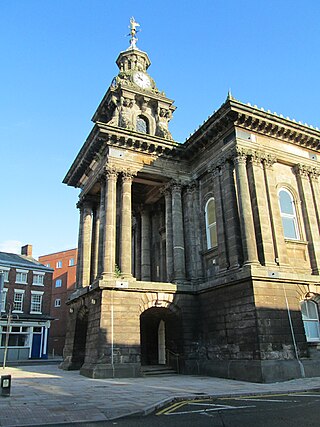
Stoke-upon-Trent, also called Stoke, is one of the six towns that along with Hanley, Burslem, Fenton, Longton and Tunstall form the city of Stoke-on-Trent, in Staffordshire, England.

Stoke-on-Trent is a city and unitary authority area in Staffordshire, England, with an area of 36 square miles (93 km2). In 2021, the city had an estimated population of 258,400. It is the largest settlement in Staffordshire and is surrounded by the towns of Newcastle-under-Lyme, Alsager, Kidsgrove and Biddulph, which form a conurbation around the city.

Newcastle-under-Lyme is a market town and the administrative centre of the Borough of Newcastle-under-Lyme in Staffordshire, England. It is adjacent to the city of Stoke-on-Trent. In 2021 the population was 75,082.

A Carnegie library is a library built with money donated by Scottish-American businessman and philanthropist Andrew Carnegie. A total of 2,509 Carnegie libraries were built between 1883 and 1929, including some belonging to public and university library systems. 1,689 were built in the United States, 660 in the United Kingdom and Ireland, 125 in Canada, and 25 others in Australia, South Africa, New Zealand, Serbia, Belgium, France, the Caribbean, Mauritius, Malaysia, and Fiji.

Staffordshire University is a public research university in Staffordshire, England. It has one main campus based in the city of Stoke-on-Trent and four other campuses; in Stafford, Lichfield, Shrewsbury and London.

Burslem is one of the six towns that along with Hanley, Tunstall, Fenton, Longton and Stoke-upon-Trent form part of the city of Stoke-on-Trent in Staffordshire, England. It is often referred to as the "mother town" of Stoke on Trent.

The Trentham Estate, in the village of Trentham, is a visitor attraction located on the southern fringe of the city of Stoke-on-Trent in Staffordshire, United Kingdom.

Stoke-on-Trent South is a constituency created in 1950, and represented in the House of Commons of the UK Parliament since 2017 by Jack Brereton, a Conservative. The local electorate returned a Labour MP in every election until 2017, when Brereton became its first Conservative MP. The seat is non-rural and in the upper valley of the Trent covering half of the main city of the Potteries, a major ceramics centre since the 17th century.

Stockport railway station serves the large town of Stockport in Greater Manchester, England. It is located 6 miles south-east of Manchester Piccadilly, on a spur of the West Coast Main Line to London Euston.

Stoke-on-Trent railway station is a mainline railway station serving the city of Stoke-on-Trent, on the Stafford to Manchester branch of the West Coast Main Line. It also provides an interchange between local services running through Cheshire, Staffordshire and Derbyshire.

Longton is one of the six towns which amalgamated to form the county borough of Stoke-on-Trent in 1910, along with Hanley, Tunstall, Fenton, Burslem and Stoke-upon-Trent. It is in the ceremonial county of Staffordshire, England.

Burslem School of Art was an art school in the centre of the town of Burslem in the Potteries district of England. Students from the school played an important role in the local pottery industry. Pottery was made on the site of the school from the early Middle Ages. The venue was refurbished and re-opened for the arts in 1999.

Stoke-on-Trent City Council is the local authority of Stoke-on-Trent, Staffordshire, England. As a unitary authority, it has the combined powers of a county council and district council and is administratively separate from the rest of Staffordshire.

The Wedgwood Institute is a large red-brick building that stands in Queen Street, in the town of Burslem, Stoke-on-Trent, Staffordshire, England. It is sometimes called the Wedgwood Memorial Institute, but it is not to be confused with the former Wedgwood Memorial College in Barlaston. It achieved listed building status in 1972.

The Carnegie Library is in Egerton Street, Runcorn, Cheshire, England. It is recorded in the National Heritage List for England as a designated Grade II listed building and "possesses special architectural and historic interest within a national context". It was built in 1906 as an extension to Waterloo House and the existing library with a grant from Andrew Carnegie, and closed in 2012.

The Old Town Hall is a former town hall in Burslem, in Staffordshire, England. It is in the Market Place, in the centre of the town. It is a Grade II* listed building, listed on 2 October 1951.

Ilkley Town Hall, on Station Road, Ilkley, West Yorkshire, is a Grade II listed municipal building designed by William Bakewell of Leeds. It forms the centre of a small complex of public buildings, which also includes Ilkley Library, and the King's Hall & Winter Garden theatre. The library, Town Hall and King's Hall opened in 1908 opposite Ilkley railway station; the Winter Garden was added to the west in 1914.

Fenton Town Hall is a municipal building in Albert Square in Fenton, Staffordshire, England. It is now occupied by local businesses, a café and an art gallery.
The Orillia Public Library is a single-branch public library in Orillia, Ontario, Canada.



















